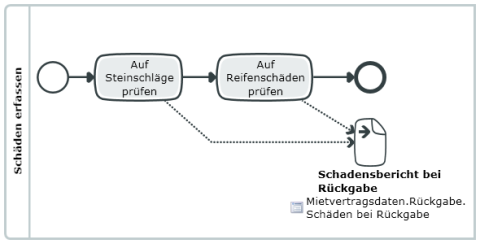BPMN diagrams are for displaying business processes in accordance with Business Process Model and Notation (BPMN 2).
You can use the established MID modeling tool to create BPMN Diagrams.
Test the Innovator Enterprise Modeling Suite for free.
Definition
The BPMN diagram is used for displaying and developing processes, as well as for using the participants in a collaboration in order to model interactions of two or more harmonized processes using BPMN 2 notation.
Interactions between participants are also modeled. Those involved in the process are shown using pools. Interactions between the pools are shown using message flows. Collaboration does not involve central controlling.
 The icon is of a diagram with an event in it.
The icon is of a diagram with an event in it.
Owner Hierarchy/Prerequisites
A BPMN diagram shows processes and collaborations as
- Definition (original) or
- View (referencing view display)
Use
The BPMN diagram can be added to a whiteboard diagram as a node.
Dependencies between processes and elements from other diagrams are shown in the whiteboard diagram.
BPMN Diagram Elements
Node
The following model elements can be displayed as nodes in BPMN diagrams.
| Icon | BPMN Element | Brief Description |
|---|---|---|

|
Horizontal Process | A process is sequence or flow of activities in an organization with the aim of completing a certain task. The display can be either with a horizontally aligned or a vertically aligned sequence flow. |

|
Vertical Process | |
  |
Collaboration |
A collaboration is collection of two or more processes working together; they have no central control and communicate using messages. |
  |
Participant (Collaboration Participant) |
A participant represents a partner and/or partner role within a collaboration. |
  |
Lane |
A lane is a sub-partition within a process in areas with common properties. Typical common properties include location, role, responsibility. |

|
Event |
An event is something that happens during the course of a process. These events affect the flow of the process. |

|
Task/Activity | A task is an atomic activity in a process. The task type provides information about the type of activity. Loop properties describe e.g. repetition or parallel or sequential execution of an activity. |

|
Global Task |
A global task is a reusable, atomic activity which can be accessed from any process using a call activity. |

|
Gateway |
Gateways are used to control how the process flows through sequence flows. |

|
Subprocess |
A subprocess is an activity whose internal details have been modeled. |

|
Data Object |
A data object is an item-aware element with limited validity in a process. |

|
Data Input | A data input is an item-aware element that collects data in the process. |

|
Data Output | A data output is an item-aware element that circulates data in the process. |

|
Data Store Reference | A data store reference refers to persistent data in a data store. They are only valid in the process. |

|
Data Store | A data store is a reusable compilation of persistent data; data store references can be used to access it. |
The BPMN diagram contains not only those elements which can be seen but also those which can be shown linked to the visible elements. These dependent elements can often be made visible using the respective configuration.
Edges
In BPMN diagrams, edges represent sequence flows, message flows, or data associations.
| Icon | BPMN Element | Brief Description |
|---|---|---|

|
Sequence Flow |
A sequence flow is a directed relationship between flow nodes (task, subprocess, gateway, event). A default flow (default after a gateway) is indicated on the source side with a backslash. A conditional sequence flow is indicated on the source side with a diamond if the source of the sequence flow is not a gateway and the flow is not a default flow. |

|
Message Flow | A message flow is a directed relationship between participants of a collaboration, between tasks/events of different collaboration participants or between collaboration participants and another collaboration participant's task/event. |

|
Data Association | Data associations link data objects and process elements. They have certain special concepts when they appear in subprocesses, tasks or events. Data associations cannot traverse process boundaries as data objects only exist within a process. |
Further Information

